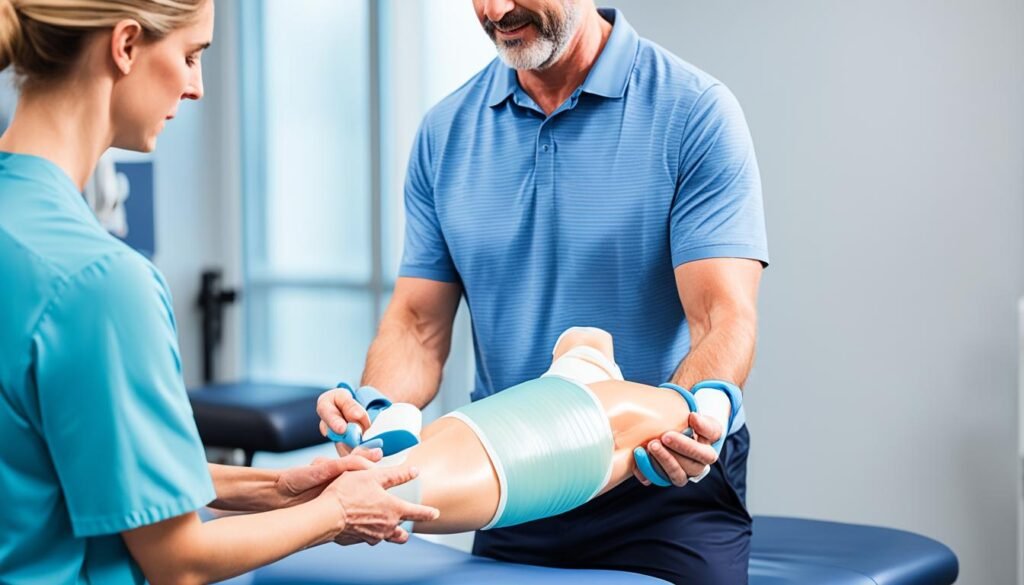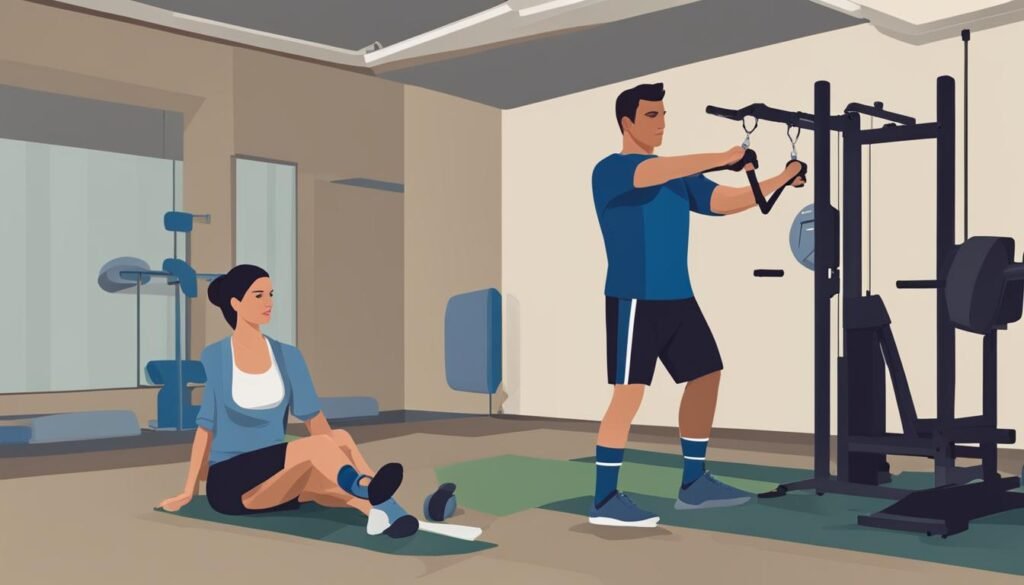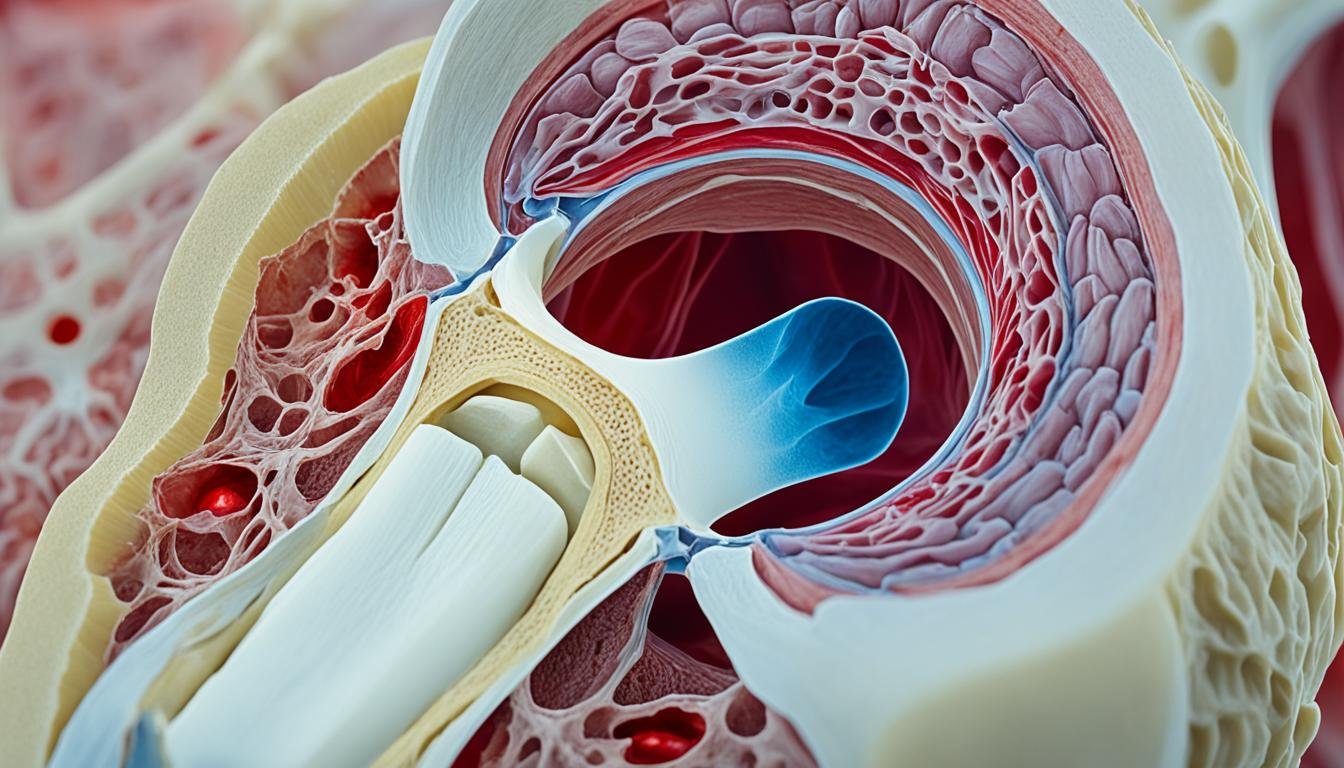Every year, over 3 million Americans face ligament and tendon tears. These injuries can lead to severe pain and make it hard to move the affected joint. Knowing how to properly manage these injuries is vital, whether you are an athlete or just someone who loves being active. There are many treatment methods available, both non-surgical and surgical, to help you recover quickly.
Key Takeaways:
- Over 3 million people in the United States experience ligament and tendon tears annually.
- Torn ligaments and tendons can cause significant pain and limit joint function.
- Proper injury management is essential for a speedy recovery.
- Treatment options range from conservative approaches to surgical interventions.
- Seeking medical attention is crucial for an accurate diagnosis and personalized treatment plan.
Understanding Tendon and Ligament Tears
Tendon and ligament tears are injuries to the soft tissues connecting muscles and joints. They can cause a lot of pain and limit how your joints move. Sometimes, surgery is needed for serious cases. The ACL tear is a common injury in the knee. Getting medical help for a diagnosis and treatment is key.
Different treatments exist for torn ligaments and tendons. The right treatment depends on how bad the injury is and the person’s needs. Some injuries might only need non-surgical treatment, while others need surgery.
Non-surgical treatment: For minor tears, non-surgical options work well. This includes resting, physical therapy, and anti-inflammatory meds. These methods aim to ease pain, help healing, and get back function.
Surgical options: Bad cases might need surgery to fix the tears. Surgery helps make the joint stable, move better, and supports an active life. Common surgeries repair or rebuild the torn parts.
“Tendon and ligament tears are tough, but recovery is possible with the right treatment.” – Dr. Smith, Orthopedic Surgeon
Torn Ligament Therapy
Therapy for a torn ligament combines exercises, managing pain, and strengthening. This helps heal and strengthen the injured ligament.
The therapy has several goals:
- To cut down pain and swelling
- To help healing and make healthy scar tissue
- To get back range of motion and joint use
- To make the area stronger and more stable
Torn Ligament Precautions
It’s vital to be careful while healing from a torn ligament. Doing so helps prevent more injury and ensures the best healing. Here are some tips:
- Avoid things that put too much stress on the ligament
- Do the rehab exercises your health expert suggests
- Wear the right protective gear during activities
- Rest when you need to, to avoid pushing too hard
Following these tips can help you recover well and lessen the risk of hurting it again.
Torn Ligament Remedies
There are also home remedies to ease pain and help ligaments heal. These include:
- Putting ice on the area to bring down swelling
- Taking pain relief meds like acetaminophen or ibuprofen as advised
- Raising the injured limb to lessen swelling
- Using compression wraps for support and steadiness
Remember, use these home remedies along with medical treatment, not instead of it.
| Treatment Options | Benefits |
|---|---|
| Surgical Intervention |
|
| Non-Surgical Approaches |
|
| Torn Ligament Therapy |
|
| Torn Ligament Precautions |
|---|
|
Always remember, each torn ligament case is different. Treatment varies based on many factors. Always see a healthcare provider for the right diagnosis and a treatment plan that fits you.
Causes of Tendon and Ligament Tears
Tendons and ligaments can tear due to sudden injuries. These tears often happen with quick movements or during sports. Football and basketball players are at a higher risk of ACL injuries. But anyone can experience these injuries, no matter their age or how active they are.
Knee meniscus tears can come from injuries or wear over time. Your lifestyle and genes may also play a role in these injuries.
Knowing what causes these tears is key to avoiding them. By understanding risky movements, you can be safer. You can change how you train and use the right gear to lower your injury risk.
Next, we’ll look at how to spot and diagnose these injuries. This will help you get help early.
Symptoms and Diagnosis of Tendon and Ligament Injuries
If you feel pain, notice swelling, or hear a pop in your joints, you might have a tear. These signs are often linked to tendon or ligament injuries. They can really limit what you can do. It’s critical to see a doctor for the right diagnosis and treatment plan.
Recognizing common symptoms
When a tendon or ligament tears, here’s what you might feel:
- Pain: These injuries can hurt a lot, especially if you move or touch the spot.
- Swelling: A tear often causes swelling, making it hard to use the joint.
- Popping or clicking sensation: Some people feel or hear a pop when the injury happens. This is a sign of a tear.
Diagnosing tendon and ligament tears
Your healthcare provider plays a big role in figuring out your injury. If you think you have a tear, here’s what might happen:
- Physical examination: The doctor will check the joint’s movement and feel for swelling or weird shapes.
- Medical history review: Talking about your past health and injuries helps the doctor understand what’s going on.
- Imaging tests: X-rays check for broken bones, and MRIs give a clear picture of soft tissue, showing tears better.
Getting diagnosed quickly and correctly helps doctors find the best way to treat you. This makes healing smoother and faster.

Treatment Options for Tendon and Ligament Tears
Treatment for tendon and ligament tears depends on how severe the injury is. Mild and moderate injuries usually don’t need surgery. Instead, they can be treated with rest, using braces, and taking medication to ease pain and swelling.
“Rehabilitation exercises play a crucial role in the recovery process,” says Dr. Jessica Collins, a renowned orthopedic surgeon. “They help improve strength, flexibility, and range of motion, allowing the injured tendon or ligament to heal properly.”
Rehab programs for these injuries include several types of exercises. Stretching, strengthening, and exercises to improve stability are common. Physical therapists who know a lot about these injuries will help you with exercises. These exercises aim to rebuild strength and make joints work well again.
Here are some important rehab exercises for these injuries:
- Range of motion exercises: These exercises are for flexibility and better joint movement. A physical therapist guides gentle movements to avoid stiffness and help healing.
- Strengthening exercises: Exercises that make the muscles around the injury stronger. They help stabilize and support the area during healing.
- Balance and proprioceptive exercises: These focus on better coordination and proprioception to avoid future injuries and improve joint function.
- Low-impact activities: Doing low-impact exercises like swimming or cycling helps recovery. They keep you fit without straining the injured parts.
In the case of severe injuries or if other treatments don’t work, surgery might be needed. Orthopedic surgeons use special methods and materials to fix or rebuild torn tendons or ligaments. This helps healing and makes the joint stable again.
Talking to a healthcare expert is key to find the best treatment for your injury. They will look at how serious your injury is, your level of activity, and your overall health. This helps them come up with a treatment plan that gives you the best chance of recovery.

Non-Surgical Treatment for Tendon and Ligament Tears
If you’ve had a tendon or ligament tear, there are non-surgical ways to help. These methods can help you heal and get moving again. They work well for injuries that are not too serious.
Resting the injured area: It’s key to let your body heal. Rest and avoid actions that hurt the injured spot.
Using ice for pain relief and swelling reduction: Put ice on the injured spot for 15-20 minutes, a few times a day. This cools the area, eases pain, and cuts down on swelling.
Applying compression with an elastic bandage: An elastic bandage can make the area stable and support it. This stops more harm and aids healing.
Elevating the injured area: Lift the hurt limb above your heart. This lowers swelling by bettering blood flow and stopping fluid from building up.
Physical therapy: A physical therapist can help you get better. They show you exercises to make the hurt spot stronger, more flexible, and heal.
Use of anti-inflammatory drugs: Drugs like ibuprofen or naproxen reduce pain and swelling. Always talk to a doctor before taking any drugs.
Quote: “Non-surgical treatments are often the first step for treating tendon and ligament tears. They’re good for handling pain and helping injuries heal, especially if they’re not too severe.” – Dr. Sarah Williams, Orthopedic Specialist
Different injuries might need different non-surgical treatments. Always see a healthcare expert for a plan that fits you and for advice.
Surgical Options for Tendon and Ligament Tears
In some situations, surgery might be needed to fix torn tendons or ligaments. It’s usually for serious injuries that don’t get better with other treatments. Or when there’s a lot of damage to the tissues. Surgery aims to make the joint stable again. It helps improve how much you can move and get you back to being active.
Common surgical options for fixing tendon and ligament tears include:
- Ligament or tendon repair: Here, the torn piece is sewn back together. It’s for less serious tears or when the ends can be put back together.
- Ligament or tendon reconstruction: For complete tears or complex cases, a replacement might be needed. A graft, from your body or a donor, is used to rebuild the tissue. This graft acts as a base for new tissue to grow.
Talking to a doctor is key before choosing surgery. They’ll look at how bad your injury is, your health, and what you want to achieve. They’ll explain the surgery, including any risks and benefits. This helps you make a smart choice.
Getting better after surgery for tendon or ligament repair can take months. It might even take longer. This depends on how bad the injury was and the surgery type. Most people need physical therapy and exercises after surgery. This helps get strength, flexibility, and movement back in the joint.
Surgery can be a good choice for fixing tendon and ligament tears. It can help you move better and feel less pain. Still, it’s important to try other treatments first. Not every injury needs surgery.
Conclusion
Torn ligaments and tendons can lead to a lot of pain and limit how well joints work. Getting a quick diagnosis and the right treatment is key. There are many ways to treat these injuries, from resting to surgery.
Knowing what causes these injuries and their symptoms can help avoid them. If you think you’ve torn a tendon or ligament, see a doctor right away. Always talk to a healthcare professional for advice that fits you.

